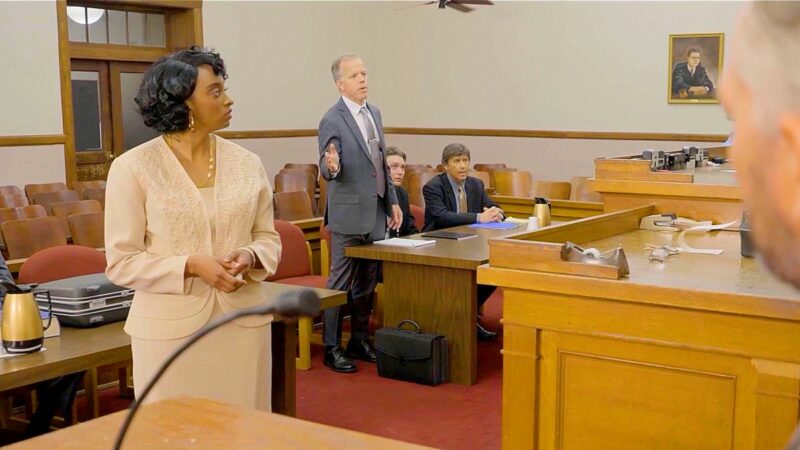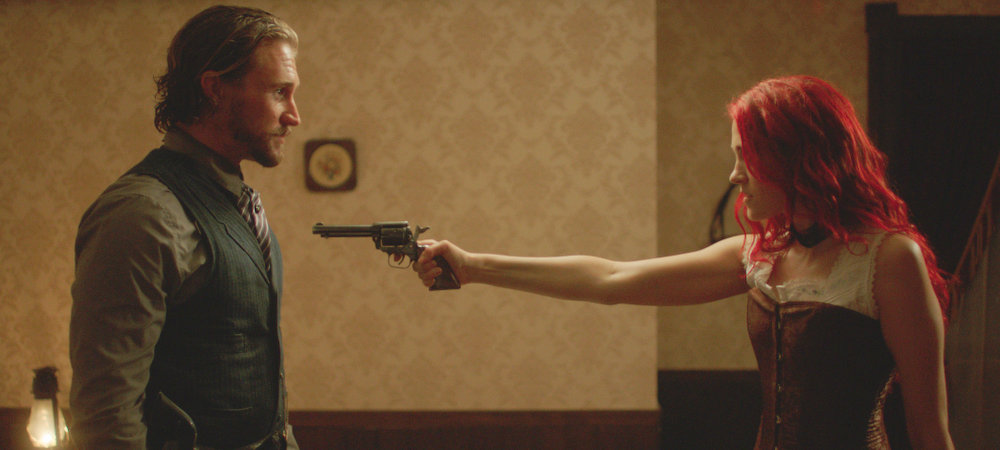
Joe Cassidy (Abby Eiland) aiming her gun at Tom Hayes (David Thomas Jenkins) in Cassidy Red
indieactivity: Introduce your film briefly?
Matt Knudsen: ”Cassidy Red” is a Western, romance, period piece about the fallout of a torrid love triangle, the body count that piles up in the wake of it, and the toll that it takes on a small town in Southern Arizona. It’s set against a sweeping desert backdrop (shot almost entirely outside of Tucson, Arizona) but is ultimately an intimate period piece and character study that spends much of its time around a smoky saloon and bordello, in a murky jail cell, and at the hangman’s gallows.
“As an alternate take on a male-driven genre, Matt Knudsen’s period Western features a female protagonist and plenty of talented women behind the scenes…” Justin Lowe, The Hollywood Reporter
The somewhat melancholy subject matter is [hopefully] offset by a central framing device in which the tragic tale of star-crossed lovers is recounted by a jovial musician who recounts the story (Princess Bride-style) affectionately, in the hopes of finding a useful moral at the end of the highly-theatrical fable. The film also leans heavily on its genre signifiers and operatic score to deliver a properly bewitching Western-throwback experience. It played at film festivals in both California and Arizona state during the summer of 2017.
indieactivity: Give a background of your experience with the story, writing, production and marketing?
Matt Knudsen: The Western genre has always been my favorite, going back to my introduction to the films of Sergio Leone as an adolescent. I had always wanted to tackle a film in the manner that Leone had- that is to say a Western that was affectionate toward its forebears while speaking loudly in a stylistically-progressive voice.
Cassidy is now available for download: Amazon & iTunes
When the opportunity came to make my first feature I had been conceptualizing the character of Josephine Cassidy in my head for months and knew that if I was going to be intimately-involved with one person’s story for the next few years of my life it had better be someone I was fascinated with to the point of obsession. Luckily, when it came to Joe, I was. To me she was a woman born in the wrong time but who was so strong-willed that she could not be forced to conform or kowtow to the whims of the men who sought to manipulate or own her.
To me, she was interesting enough to explore cinematically because she was the kind of character who I had always wanted to see profiled in a Western but never had. So I took it upon myself to make that kind of film. The writing process happened quickly as I mowed through about ten drafts in less than nine months. It was the quickest script I had ever written and in retrospect I realize that most of the major set pieces were things I had been dreaming about for years- working them out in my head before I had a home to write them into.
We starting shooting about a month after I had locked my last draft and wrapped principal photography just shy of year after I had written word one. Post-production, marketing, festival submission, and distribution were all MUCH slower processes.
indieactivity: Did you start writing with a cast (You or any) in mind?
Matt Knudsen: Not especially. The only character who was written with someone in mind was Rowena. One of my oldest friends is an amazing actress named Lola Kelly and I had been looking for an opportunity to collaborate with her for a long time. She was one of the first people I showed an early script to and luckily she agreed to play Rowena. She was the first person cast.
indieactivity: How long did you take to complete the script?
Matt Knudsen: The first draft was done in three months. I basically averaged about a draft a month for the next nine. My process is basically glowing over my laptop in gleeful, ecstatic abandon when I’m getting all of my first ideas down on paper. I always feel certain that I’m the second coming of Paddy Chayevsky as I’m printing out my first draft.
Then I show it to a few people, get their notes, and spend the next few days in a dark cloud-infested funk of disillusionment, feeling like I should never attempt to write anything ever again. I can’t believe how many things I was certain were brilliant that aren’t working, how many structural issues have surfaced and appear to be unfixable, how many conversations are overwritten, etc.
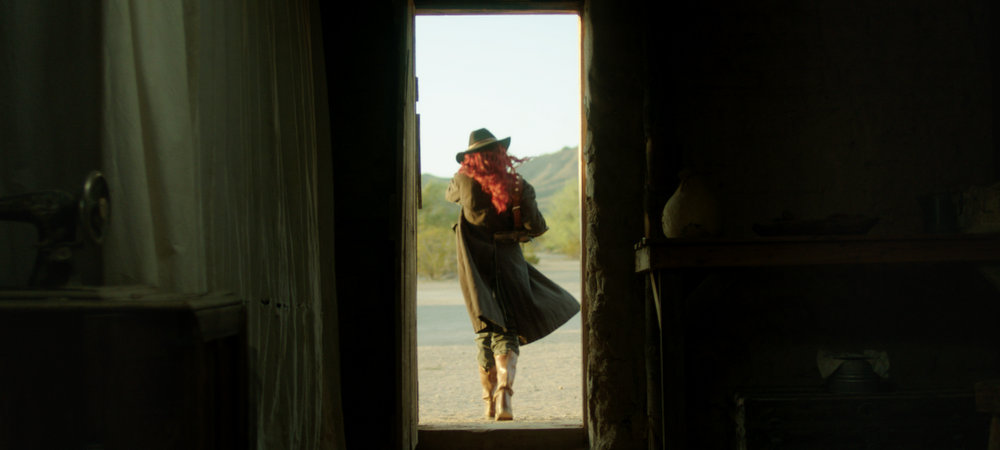
Joe Cassidy (Abby Eiland) exits in Cassidy Red
Should I throw the draft off a bridge and start from scratch? Should I throw myself off the bridge?? Then after a couple days of that I drag myself out of the funk, re-mount my keyboard and start digging in for the hard work. It’s a process.
indieactivity: How did you develop ‘your film’?
Matt Knudsen: Cassidy Red was developed as my thesis project while I was a student in the graduate directing program at UCLA’s School of Theater, Film and Television. I wrote it in a screenwriting class, I developed it with my faculty thesis committee, I hired almost exclusively enrolled or recently-graduated students for the crew, and the first handful of test screenings were done in our editing classes. It’s a period feature film with a cast of 50+ and a crew of 100+ that took nearly 3 years to complete. But ultimately it is a student film production, first and foremost.
indieactivity: How was it financed?
Matt Knudsen: A combination of departmental incentive-funding, grant monies, scholarships, student loan disbursements, crowd-funding contributions, familial investments, and good, old-fashioned credit cards.
indieactivity: Is there anything about independent filmmaking you struggle with?
Matt Knudsen: Fund-raising and publicity. Both are absolute anomalies to me. I was always terrible at math, I struggle with frugality, and I can’t stand self-promotion. As such it’s like pulling teeth for me to locate financing that comes from somewhere besides my bank account (see above) and the carnival-barking it takes to get the film in front of an audience absolutely makes my skin crawl. I’m quite confident with my skills as a writer and I’m awfully good on set (I’ve done virtually every job from PA to director in the last 15 years) but anything involving money or PR I’m absolutely useless at.
indieactivity: How long was your pre-production?
Matt Knudsen: About 3 months, give or take.
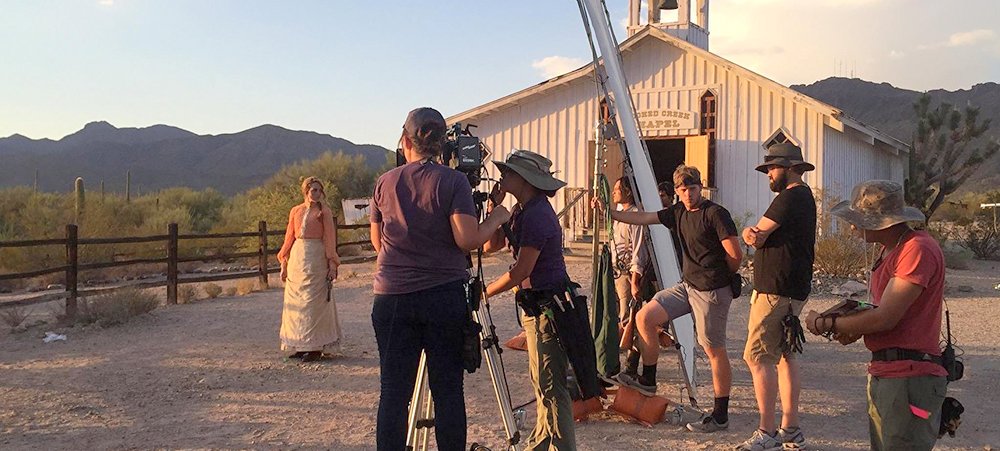
The crew of Cassidy Red on set shooting a scene
indieactivity: What was your rehearsal process and period?
Matt Knudsen: Virtually non-existent. We couldn’t really afford to book our SAG actors for much more than production days and costume fittings. So we worked a few very casual rehearsals and table reads in here and there but for the most part we did our first real rehearsals on set. I also found out later that some of the principles were holding their own impromptu rehearsals at their hotel or in the passenger van to set in the morning. Brooks Yang, our producer, drove them home a few nights and got to hear them rehearse some scenes. I was always quite jealous of that.
indieactivity: You shot the film in days. How long were your days?
Matt Knudsen: 18 shooting days in total plus 3 days of “pickups” and inserts. 3 weeks of 6 days then a 3-day weekend which took place about 6 months later (long story). I was very adamant about never working longer than a 12-hour day. I’ve spent enough time toiling below the line that I know how important it is to adhere to this doctrine. Unfortunately (and you’d have to check with Brooks about this) I think we did go over 3 times on the shoot. But we made sure that we adjusted our call times to honor a proper, 12-hour turnaround. Regardless, I’m still embarrassed about this. I HATE going over and I find it to be extremely disrespectful to the crew.
indieactivity: Did the tight shooting schedule make it harder or easier? How did it affect performances?
Matt Knudsen: I mean… yes harder, of course. But it’s all relative, right? EVERYBODY could use more time. Always. But if the tightness of our schedule was beneficial to me it was because it forced me into brutal pragmatism and simplification.
I do tend to over-shotlist and I always overwrite dialogue. Pretty much every day was an exercise in pairing the dialogue down to a sharp point and working the shotlist down to the bare essentials. If nothing else, this made our editor John’s life that much easier. I can’t speak to each actor’s experience with this squeeze but I was uniformly impressed with all of them and feel the performances are strong across the board- particularly Abby who was on set virtually every day.
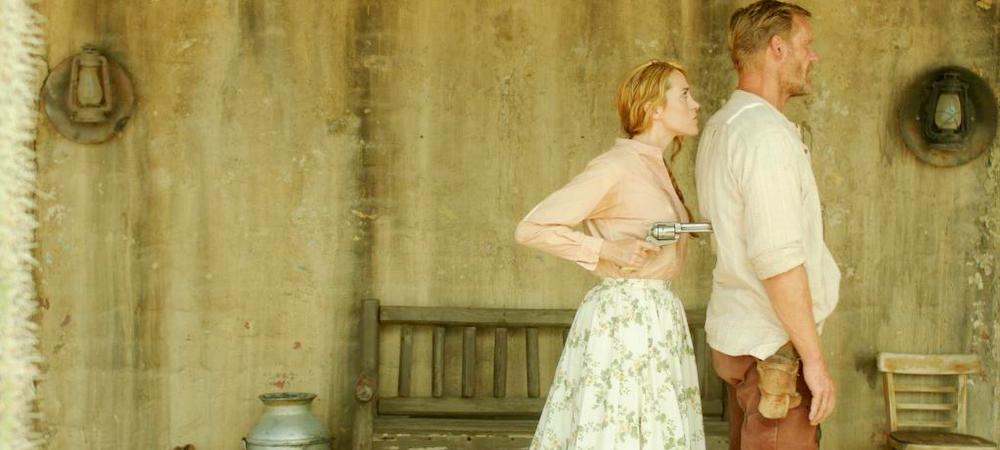
indieactivity: How much did you go over budget? How did you manage it?
Matt Knudsen: It’s hard to say. The budget was always fluid (my fault, not Brooks’). I just kept working other jobs during post production and filtering basically everything I was making into the movie.
indieactivity: How important is marketing? Do you think a project can make any dent without it these days?
Matt Knudsen: Unfortunately it’s probably essential. I would prefer to not be involved in it but with a film this small I have to do my part. I’m trying my best but I feel like I really show my age when it comes to hashtags and gifs.
indieactivity: What was the experience like of working with such a small crew (?)?
Matt Knudsen: It was glorious. It’s actually one of the larger crews I’ve ever worked with in terms of things I’ve directed. I feel like the size of the team we had to work with was absolutely perfect for our circumstances but we literally could not have sacrificed one person. We basically brought all department heads and most crew members out to Arizona from LA and we all lived together in a house close to set.
Most of us were already classmates and friends before we started shooting. But the experience of living and working in such a volatile environment (110 degrees one minute, torrential monsoon the next…) I think (I hope?) brought us all even closer together. If I could work with the Cassidy Red team on everything I ever make for the rest of my career I’d be an extremely happy director.
indieactivity: The film looks stunning. How did you get such a good look when shooting so fast?
Matt Knudsen: All of the credit goes to three amazing women- Julia Swain, our DP, Lauren Ivy, our Production Designer, and Brianna Quick, our costume designer. They’re three of the most talented and resourceful artists I’ve ever worked with and they all came to the project well aware of what we were up against. Julia and I are very close, all of our visual references are the same, we love all of the same DPs, and we seem to trust each other intrinsically.
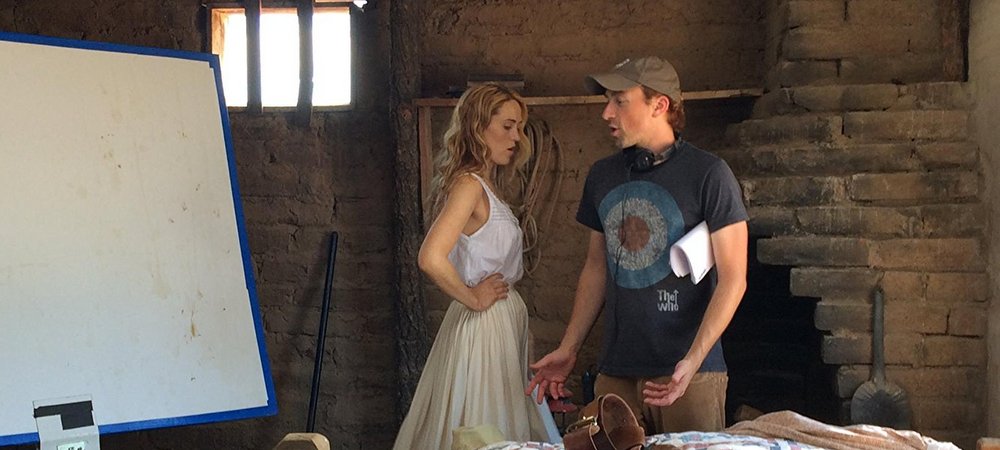
Matt Knudsen on set discussing a scene with Joe Cassidy (Abby Eiland) in Cassidy Red
So if she tells me she’s sure that we can cover a scene in a oner I won’t question her and if I tell her that I don’t mind the exposure on an actor’s fill side going completely black she’ll believe me. We spent a long time shot-listing every single scene in gruesome detail before we even left for Arizona and, for the most part, didn’t change much when we got to set. We also storyboarded the entire climactic shootout. This was my first time ever working with Lauren but I had an instinctive feeling about her when we first met (which was only about a month before production).
We were positively simpatico for the run of the shoot. I told her very little beyond our first conceptual meeting and I honestly can’t think of any time that she put something in the frame that I disapproved of. Her instincts are spot-on (or, at the least, very much in line with mine) and I feel like I spent the whole production thinking Lauren had some kind of tapped phone line into my head. Brianna is equally self-sufficient. We had quite a few meetings and I gave her a ton of references and films to look at during pre-production. But I knew she didn’t need much from me.
Like Lauren, her instincts are razor sharp and we share so many of the same tastes. We had a shorthand when it came to color and style that was practically non-verbal. I have so many wonderful memories of laughing and smiling with Brianna on set but it rarely had anything to do with the costumes. She was so far ahead of me and so prepared that she needed very little input.
indieactivity: Did you look at rushes? On what format?
Matt Knudsen: Julia and I watched prores quicktimes, exported from the SSD cards, every night after we wrapped. Occasionally we would spot-check things at lunch time but this was a rare luxury.
indieactivity: What were the advantages and disadvantages in the way you worked?
Matt Knudsen: The advantage of working with a limited crew of mostly students who knew each other meant that there was rarely any drama, we enjoyed each other’s company on and off set, and we were realistic about our expectations toward one another. It’s extremely important to me to run a polite and respectful set where everyone works with each other safely, calmly, and professionally.
This disadvantages to this kind of environment was that most of the student-heavy crew was either working for free or for very little pay. This was obviously the necessity of a shoe-string production held up by loans, favors, crowdsourcing, and discounts. Hard work should be compensated properly but, unfortunately, it often wasn’t on this “labor of love”.
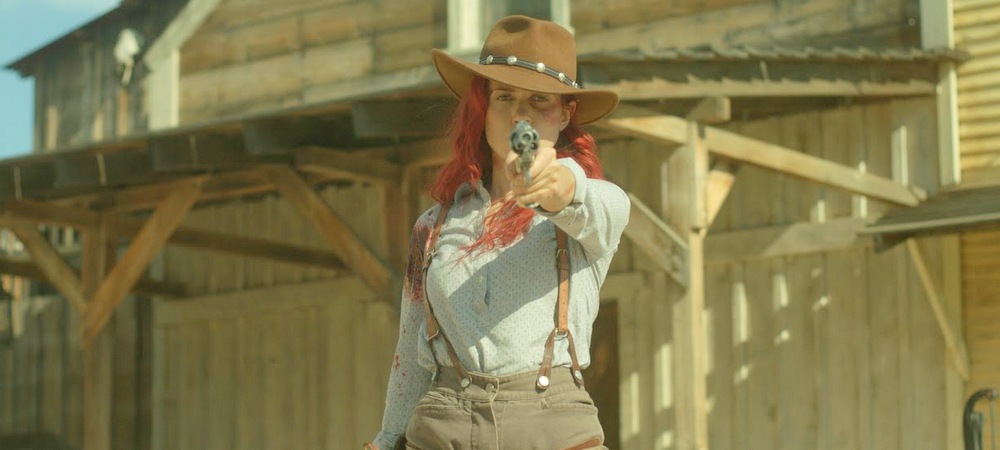
Joe Cassidy (Abby Eiland) ready to shoot
Everyone knew the kind of project this was when they signed onto it but I still felt quite guilty about how many people were working extraordinarily hard for little more than food, credit, and gratitude. Someday I would love to pay people properly. Not being able to is my least favorite part of the independent film “struggle”.
indieactivity: What else have you got in the works?
Matt Knudsen: I’ve got a few feature projects that I’ve written and would love to start developing before the end of the year. One of them is a Western that’s very different in tone from Cassidy Red but also features a complicated woman at the center of it. One of the scripts is a “supernatural comedy” set at a couple’s retreat in Baja. It’s kind of The Big Chill by way of Freaky Friday. I also have pilot scripts and series proposals that I would be interested in exploring one of these days. It would be fun to bounce back and forth between feature and “television” projects (or whatever word we’re using to describe serialized work these days) every couple of years. Who knows which way the industry winds will be blowing as early as tomorrow?
In Camera by Naqqash Khlalid Launch on VOD April 29
Naqqash Khlalid’s Directs Nabhan Rizwan. In Camera stars an EE BAFTA Rising Star Award Nominee.
2025 Philip K. Dick Sci-Fi Film Festival Award Winners Announced
Vanessa Ly’s Memories of the Future Awarded Best PKD Feature
Dreaming of You by Jack McCafferty Debuts VOD & DVD for April Release
Freestyle Acquires “Dreaming of You” for April 15th Release
Hello Stranger by Paul Raschid set for London Games Festival & BIFFF
The film Is set for an April 10th Premiere at The Genesis Cinema in London (LGF) and BIFFF
Daydreamers Official Trailer by Timothy Linh Bui: Released by Dark Star Pictures
Daydreamers Vietnamese Vampire Thriller – May 2nd release
Afternooner by The Harrow Brothers: Funniest Movie of the Decade on VOD & DVD April
Freestyle Acquires “Afternooner” for April Release

